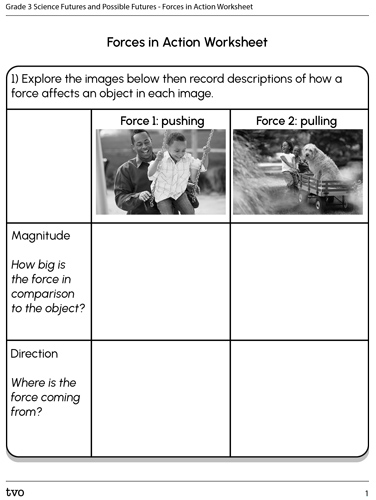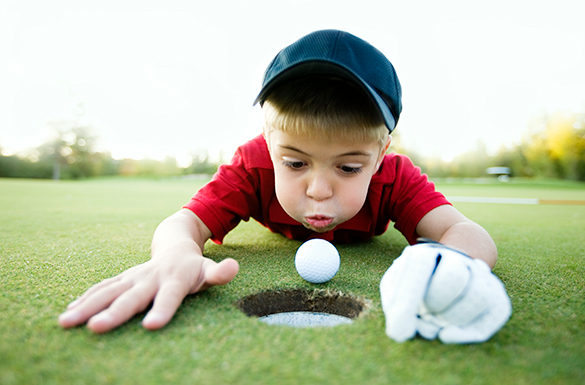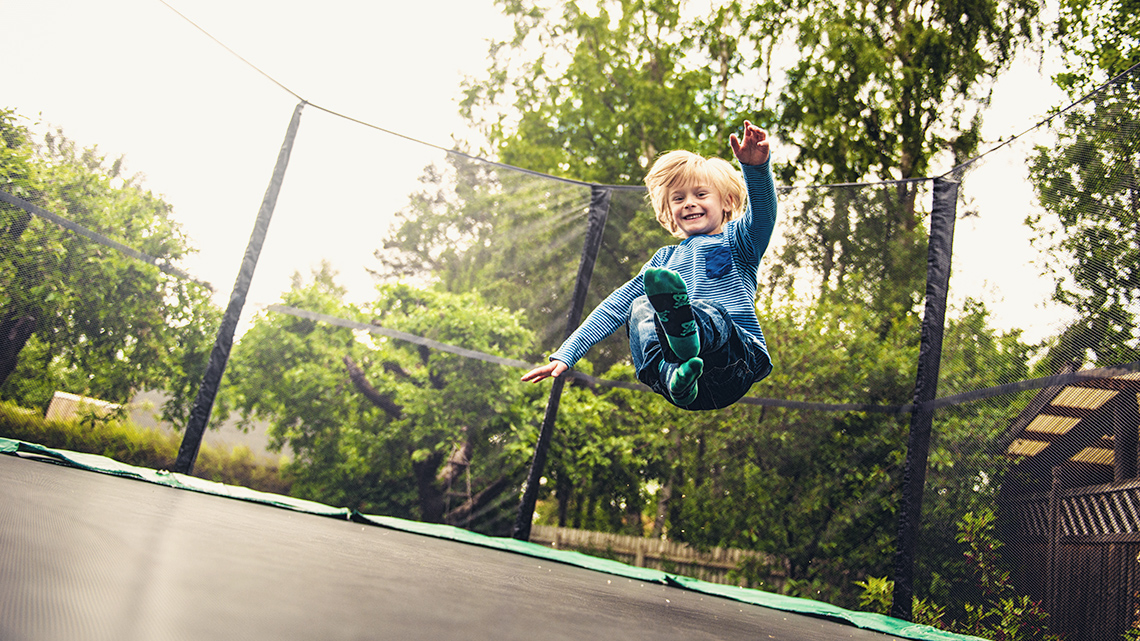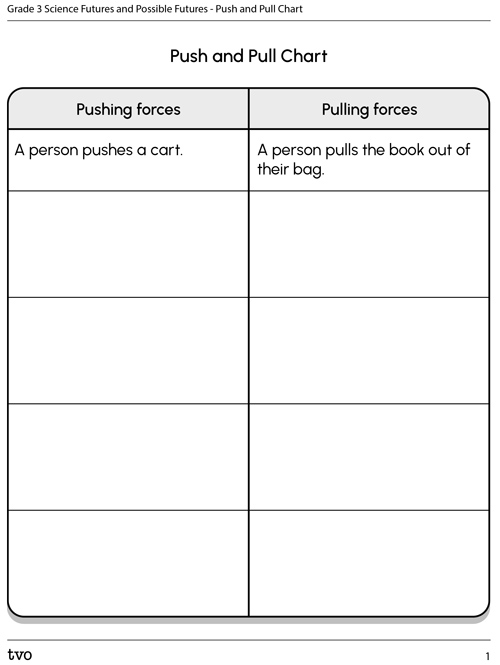Minds On
What makes them “work”?
Forces are all around us. They cause movement. There are many kinds of forces. The two main kinds are “pushing” and “pulling” forces.
Explore the following images. What do you notice about each example?

Examples of a pull force include pulling a rope tied to a heavy box, pulling on a kite flying in the wind, and pulling a block from a stack of blocks as part of a game. Examples of a push force include pushing a hoop with a stick outside, pushing on dough to knead it, and pushing a door closed.
Think about the environment around you, or another space of your choice. What are some different push and pull forces that you can identify?
Complete the Push and Pull Chart in your notebook or using the following fillable and printable document. If you would like, you can use speech-to-text or audio recording tools to record your thoughts.
Action
Contact and non-contact forces
All forces can be put into two categories: contact and non-contact.
A contact force is a force that acts on an object by coming into contact with it (touching it).
A non-contact force is a force that happens because of the attraction or repulsion of two objects that don’t touch each other.
Brainstorm
Everyday forces
Can you brainstorm any examples of contact or non-contact forces you encounter in your everyday life?
Press ‘Answer’ to access one possible answer.
|
contact forces |
opening a door, kicking a soccer ball, riding a bike, pushing in a chair |
|---|---|
|
non-contact forces |
snowflakes falling, clothing items that cling together |
Forces vocabulary

Press the following tabs to access vocabulary used to discuss forces.
Forces are needed to lift, turn, move, open, close, push, or pull an object.
A force can change the direction of a moving object.
Motion is when an object changes its position or location.
Gravity is the natural attraction between two objects that is constantly pulling objects towards Earth.
A push force moves an object away from something. For example, pushing a cart.
A pull force brings an object closer. For example, pulling a wagon.
Strength is the amount of force that is applied to an object.
Check your understanding!
For each term, select the corresponding definition.
Explore the following video of people riding bicycles.
- What forces do you notice in the video?
- Is the force causing motion? How do you know?
- Where is the force being applied (strength)? Is it push or pull?
Record your answers using a method of your choice.
Press ‘Review’ to check your answers.
|
1. |
There is a pushing force on the pedals, and a pushing force of wind against them. Gravity is the force keeping them on the ground. |
|---|---|
|
2. |
Yes, because the bikes are moving. |
|
3. |
A pushing force is being applied to the bike pedals and the wind is also pushing against them. The force of gravity is pulling them towards the ground. |
Forces acting on structures
Forces act on all structures. Whether the structure is small or large, it must be designed and built to withstand forces.
To describe how any force is acting on a structure, engineers talk about three main things:
- the force’s magnitude
- its direction
- the point and plane of its application
Explore the following definitions of qualities of forces and match them to the examples involving wind.
Now complete the Forces in Action Worksheet in your notebook or using the following fillable and printable document. If you would like, you can use speech-to-text or audio recording tools to record your thoughts.

Press the Activity button to access the Forces in Action Worksheet.
Activity (Open PDF in a new window)Press ‘Example’ to access an example of how to describe a force affecting an object.

Here is an example of how to describe the force affecting the object in the previous image:
|
Magnitude |
A golf ball is small and pretty light. The magnitude of this force is likely stronger or larger than the golf ball. |
|---|---|
|
Direction |
The force is being blown, or pushed, on one full side of the golf ball from behind. |
|
Point of application |
The point of application is one full side of the golf ball. |
|
Outcome |
The ball moves forward, at a slow speed, to get in the hole. It does not affect the shape of the object. If the golf ball was blown on from the other direction instead, it would cause the golf ball to change direction. If the force was blown on the golf ball from both sides at the same time, it would likely stay in one spot, or move in the direction away from the stronger force. |
External forces
Every structure needs to support a load.
The total load is the sum of the static and dynamic loads.
The static load is the effect of gravity on a structure.
The dynamic load is the forces that move or change while acting on the structure. It is called “dynamic” because these forces change their magnitude, direction, and point and plane of application over time.

A car driving over a bridge. There are two external forces at work, the weight of the truck (dynamic load), and the weight of the bridge (static load).
Gravity is an external force that acts on all structures all the time. Gravity is the natural force of attraction between two objects. Gravity constantly pulls structures toward Earth’s center.
Explore the following Space Kids video entitled “What is Gravity?” to learn more about gravity.
Check your understanding!
Check your understanding about external forces.
Internal forces
Structures also experience internal forces. Depending on the direction in which they act, internal forces can be classified as compression, tension, shear, or torsion.
Explore these forces in the following infographic.

There are four internal forces which include compression, tension, shear and torsion. Compression means pushing down on an object, tension means pulling up on an object, shear means rubbing together of two objects and torsion means twisting.
Check your understanding!
Explore the following images to identify what internal force it is. Select the correct answer, then press ‘Check Answer’ to see how you did.
Let’s experiment! Create your own experiment
Your task is to design an experiment that answers one of the following big ideas:
- How do forces affect an object?
- How do humans control the forces or the effects of forces?
- What forces do engineers consider when designing a building?
Press ‘Examples’ to access possible example options for this experiment.
|
Examples of possible experiments |
|---|
|
1. How does shape affect motion? (Explore how the shape of something affects the motion of it. e.g., like a flat piece of paper vs. a piece of paper crunched into a ball.) |
|
2. How does the weight of an object affect motion? (Explore the force of gravity by designing an experiment that investigates how the weight of an object affects the speed that it falls.) |
|
3. Design an experiment that shows the difference between the force of a push and a pull. |
|
4. How does the force of wind impact a structure? |
|
5. How does the strength of a force (such as someone pushing something) impact the speed or direction of an object? |
Before you begin designing your experiment, explore the following example:

Press the Activity button to access the Example Experiment Outline.
Activity (Open PDF in a new window)Design your experiment using the following fillable organizer, or in another method of your choice.
Your experiment design needs to include the following:
Experiment design checklist
Include the following in your experiment design:
Complete the My Experiment Outline in your notebook or using the following fillable and printable document. If you would like, you can use speech-to-text or audio recording tools to record your thoughts.
Press ‘Extension’ to reveal how you can extend your experiment.
If possible, conduct (or have someone else conduct) your experiment following the steps you outlined, and record observations.
- What went well with your experiment?
- What would you change next time? Why?
- Was your prediction correct? Why or why not?
Consolidation
Reflect and connect
Reflect on what you have learned about forces in action by completing the following fill-in-the-blank activity.
For each sentence, select the missing word from the drop-down menu.

Pause and Reflect
Forces in action
- What forces can act on a structure? Give an example of each type of force.
- What is the difference between contact and non-contact forces? List at least two examples of each type of force.
- What do engineers need to consider when designing a structure?
Record your responses using a method of your choice.
Reflection
How do you feel about what you have learned in this activity? Which of the next four sentences best matches how you are feeling about your learning? Press the button that is beside this sentence.
I feel…
Now, record your ideas about your feelings using a voice recorder, speech-to-text, or writing tool.

